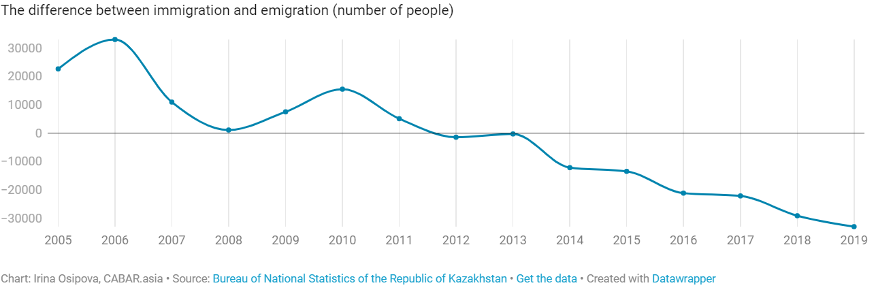Migration pattern in the Eurasian space – Kazakhstan in focus
Migration 15 January 2022In wake of the turmoil occurring in Kazakhstan, this article aims to bring a latest synthesis over its migratory trends and flows, though a statistical data overview on this phenomenon.
Kazakhstan’s external permanent emigration statistics for 2020 show a significant reduction in the number of emigrants. Only 21 thousand people left between January and September 2020, according to the Eurasian Economic Commission (EEC), which is 61 percent less than the same period last year. The coronavirus pandemic, according to some, could cause migration to be delayed. Due to the closed borders, people who wanted to leave were unable to do so. However, only after the borders are opened will it be possible to confirm or refute this viewpoint.
The migration patterns are like those seen in other Eurasian Economic Union countries. Kazakhstan, on the other hand, has the highest negative net migration rate, according to data from EEC analysts published in the EAEU Statistical Yearbook. Kazakhstan’s population had increased by 236,602 since January 1, 2019, to 18,632,169 at the start of 2020. Natural population growth was 269,575 people, while net migration was 32,973 people. As a result, the population’s net out-migration increased by 13.2 percent in 2019 compared to 2018. Kazakhstan is among the top 20 countries in terms of population migration movement relative to the total population, according to the International Organization for Migration’s World Migration Report 2020.
Kazakhstan was surprisingly ranked among the top 20 countries in terms of both foreign born and emigrated population. During the last 30 years of Kazakhstan’s recent history, population outmigration has been more prevalent. Both natural population decline and large outmigration contributed to the highest rates of overall population loss of 7.7% in the 1990s. However, in the 1990s, the effects of outmigration were much more pronounced, resulting in a population loss of more than a million people across the country. This pattern continued until 2003, when net migration for the first time since Kazakhstan’s independence turned positive in 2004. Between 2004 and 2011, the annual number of immigrants entering Kazakhstan outnumbered the number of emigrants leaving the country, resulting in a positive net migration balance.

In terms of migration, Kazakhstan is extremely dependent on other Post-Soviet countries, which account for nearly 80% of all immigration and nearly 90% of all emigration. Uzbekistan accounted for 34.4 percent of all immigrants to Kazakhstan in 2018, followed by Russia (30.6 percent) and China (10.7 percent). The vast majority of Kazakhstani emigrants also chose Russia as their destination (87.8 percent). In terms of migration, Russia continues to be the most influential country in Central Asia.
In 2019, there were nearly 5 million Central Asian migrants living in Russia. The migration patterns from Central Asia to Russia differed by Central Asian country. Remittances from Russia are vitally important economically for Tajikistan and Kyrgyzstan, and the vast majority of migrants from these two countries, as well as from Uzbekistan, are low-skilled labor migrants. The vast majority of Kazakhstani migrants, on the other hand, were highly skilled workers and students. However, the overall demographic impact of migration on Kazakhstan decreased dramatically in the early 2000s, and net migration has never exceeded natural population growth in the last 15 years. From 2004 to 2019, the total population grew at an annual rate of nearly 1.4 percent on average. The migration patterns in Kazakhstan from 2000 to 2019 appear to be in line with the country’s overall economic indicators. Since 2012, net migration has shown increasingly negative dynamics, with net outmigration for the eighth year in a row. We can expect a continuation of the outmigration process, given the current economic situation and the negative projections for 2020.
Estimated time of reading: ~ 3 minutes
Written by: Nenad Stekić
Submitted on: 14.01.2022


